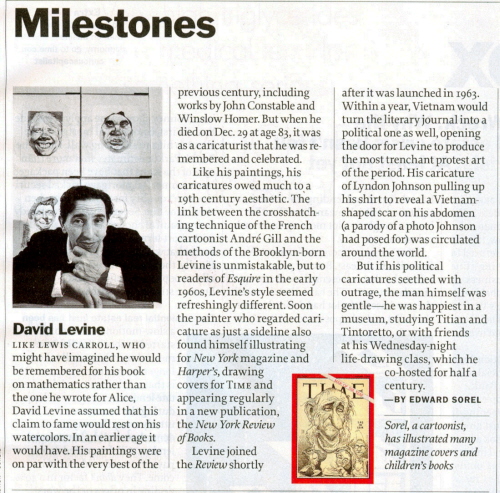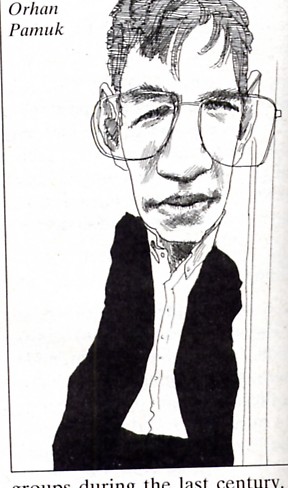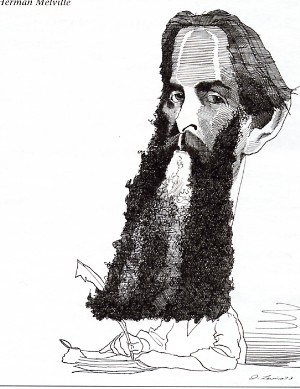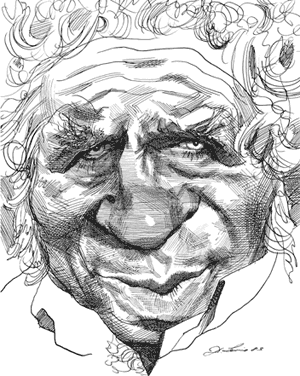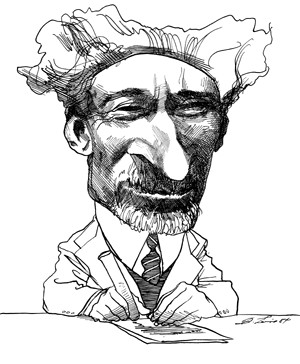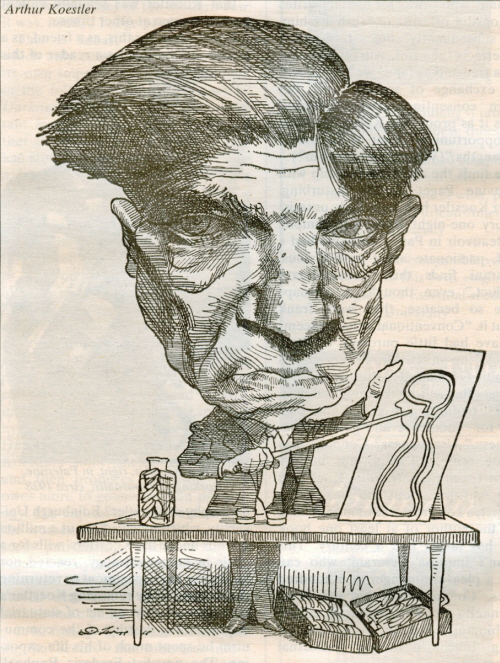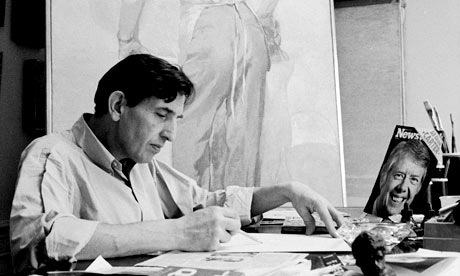- guardian.co.uk, Thursday 31 December 2009 17.14 GMT
- Article history
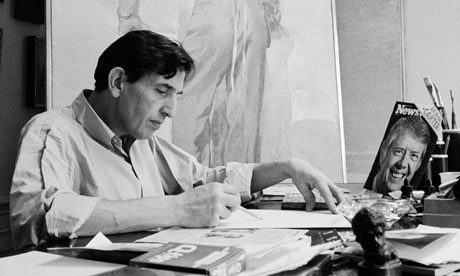
David Levine in his studio in 1976 Photograph: Alfred Eisenstaedt/Time Life Pictures/Getty Image
In 1966 President Lyndon B Johnson, recuperating from gall bladder surgery, met reporters and pulled open his shirt to show them the scar from his operation. A few months later, in the New York Review of Books, the artist David Levine, who has died aged 83, drew Johnson opening his shirt to reveal a scar shaped exactly like a map of Vietnam. Beyond the impact of the image itself, with a few deft strokes Levine also imbued his LBJ with sadness; opening himself to the world, morosely aware that eyes would be drawn, inevitably, to the festering sore that was the Vietnam war. He revisited Johnson as a tragic figure when Time magazine named the president Man of the Year in 1967. Levine's cover portrayed LBJ as King Lear.
This ability to delineate subtleties of character made Levine America's finest political caricaturist since the 19th-century heyday of Thomas Nast. He drew Henry Kissinger, under an American flag blanket, copulating with the world, a female figure with the globe as her head. Another image of Kissinger, covered with tattoos representing wars, coups and assassinations, surfaced only recently in a collection of drawings that had been rejected by the New York Times editorial page.
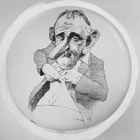 Levine's
caricature of President Johnson, showing the Vietnam-shaped scar
Photograph: Walter Daran/Time & Life Pictures/Getty Image
Levine's
caricature of President Johnson, showing the Vietnam-shaped scar
Photograph: Walter Daran/Time & Life Pictures/Getty Image
Levine was a master of visual metaphor, but apt as it was to portray Jimmy Carter as Nero, it was the oblivious bliss on Carter's face that made the caricature work. Expressions were the focus of his outsized faces, placed on withered bodies, often with the noses greatly exaggerated, creating a path for the viewer to his subject's eyes. He drew Richard Nixon more than 60 times, as everything from Don Corleone to a foetus; the ski-jump nose and five o'clock shadow framed a set of always-desperate eyes. In those days, many readers would have agreed with Levine's comment that "political satire saved the world from going to hell".
Levine was born and lived for most of his life in Brooklyn, New York, his "small town". For years he was the centre of an informal breakfast club at Teresa's restaurant in his Brooklyn Heights neighbourhood. His father was a pattern cutter, his mother a nurse and dedicated communist. A "red-diaper" baby, he sold copies of the Daily Worker, but the greatest thrill of his childhood was shaking hands with Franklin Delano Roosevelt when the president visited a Brooklyn sports ground. "My right hand has been bigger than my left ever since," he joked. His precocious artistic talent saw him taking classes at the Pratt Institute and the Brooklyn Museum before he had finished at Erasmus high school.
He studied education at Temple University, Philadelphia, and after two years in the army, studied fine art at Temple's Tyler school. His first love was painting, and, returning to New York, he studied with the abstract expressionist Hans Hofmann. Levine's own work was more realist, recalling earlier great New York artists such as John Sloan or John Marin, particularly in his watercolours, many of women on the beach at Coney Island, whom he called "shmatte ladies", using the Yiddish word for the rag trade.
In 1958, along with Aaron Shikler, Levine founded the Painters Group in Brooklyn; 50 years later they would be commissioned to produce a series of portraits of the rightwing Supreme Court Justice Sandra Day O'Connor. Levine worked as a commercial artist until, in 1960, he began drawing for Esquire. He joined the New York Review of Books soon after it was founded, in 1963, to fill the gap in newspaper book supplements caused by a printers' strike. He stayed with them until 2007, when failing eyesight made fine line work impossible.
Beyond politics, he covered the full gamut of literary figures and other celebrities – Allen Ginsberg with frazzled hair and beard forming a map of the US, Bertrand Russell as a hippy giving the peace sign, CP Snow as Humpty Dumpty with huge, horn-rimmed spectacles. The magazine would send a copy of the article he had been commissioned to illustrate, and photographs of the subject, to him at the Brooklyn Casino, where he played tennis. His finished work was then collected from there.
In 2008, an exhibition and an accompanying book celebrated Levine's portraits of presidents. Oddly, he had great trouble with the anodyne features of George W Bush. He did portray Bush as a modern centurion, or a pious wolf in sheep's clothing, an image he had also used for Bush's grandfather, Senator Prescott Bush. As John Updike once wrote of Levine: "In a confusing time, he bears witness. In a shoddy time, he does good work."
Levine had been suffering from macular degeneration, which took much of his sight, and prostate cancer. He is survived by his second wife, Barbara Hayes, a son and daughter from his first marriage, and a stepson and daughter from his second.
• David Levine, artist, born 20 December 1926; died 29 December 2009

